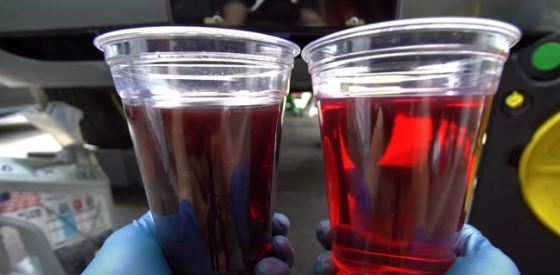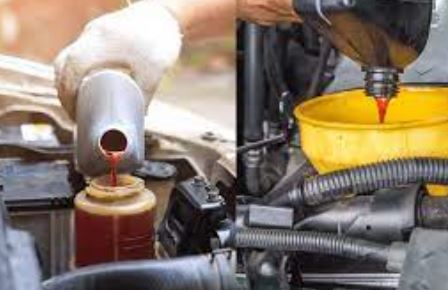Transmission fluid is a must for a vehicle’s transmission system, as it lubricates the parts and avoids overheating. Mixing synthetic and regular transmission fluids might work in some cases, but caution is advised. The compatibility of these fluids depends on their chemical composition, age, and condition. Troubles, such as leaks, low effectiveness, or damage to the transmission system, can be caused by mixing the two kinds of fluid. Also, the warranty may be affected if issues come up because of the mixed fluids. Thus, consulting a trusted mechanic is key before blending them.
If you’re ready to learn about can You Mix Synthetic Transmission Fluid With Regular Transmission Fluid . We must consider a few elements before making any decisions. That involves understanding types of transmission fluid, when they need changes, and how do you change them? Professional help before making changes may help avoid any damages or future costs.
In past days, only hydraulic-based automatic transmissions used ATF and oils like 10W30 engine oil for manual transmissions. Nowadays, engines are very advanced with more gear ratios fitted into one transmission case. Such complex systems come with higher factory-recommended maintenance costs.
Understanding Synthetic Transmission Fluid and Regular Transmission Fluid
To understand the difference between synthetic transmission fluid and regular transmission fluid, you need to know the characteristics of each fluid. Mixing these two types of fluid can have serious consequences for your vehicle’s transmission system. In this section “Understanding Synthetic Transmission Fluid and Regular Transmission Fluid”, we’ll delve into the characteristics of Synthetic Transmission Fluid and Regular Transmission Fluid as a solution.
Characteristics of Synthetic Transmission Fluid

Synthetic transmission fluid has lots of advantages over regular transmission fluid. Check out these features to find out why!
| Property | Synthetic Transmission Fluid | Regular Transmission Fluid |
| Viscosity Stability | Keeps its viscosity in extreme temps. Less wear on gears. | Viscosity drops in high temps. Gears wear out faster. |
| Oxidation Resistance | Resists oxidation better. Longer fluid lifespan. | Breaks down quickly due to oxidation. Need to replace often. |
| Foaming Tendency | No foam under pressure. Smooth gear shifts. | Foams easily. Jerky gear shifts. |
| Cold Weather Flow Properties | Doesn’t harden or thicken in cold temperatures. Smooth operation when starting up. | Harden and thicken in cold weather. Stiff shifting after start-up. |
| Additive Quality Control | High quality control standards with precise additive ratios. Consistent performance and protection levels. | Poor Additive Quality Control. Inconsistent mixture ratios make performance specs hard to identify. |
Synthetic transmission fluid lasts longer and performs better in harsh conditions. Get the benefits of using it today!
Characteristics of Regular Transmission Fluid

Regular Transmission Fluid: Unique Qualities
Regular transmission fluid is made for use in automatic transmissions. It has several properties to keep your transmission running smoothly. These include:
- Lubrication: Protects from damage caused by friction.
- Abrasion resistance: Prevents wear and tear from moving parts.
- Oxidation resistance: Stops oxidation or degradation.
- High Boiling Point: Withstands loads and heat without breaking down.
Regular transmission fluid can degrade over time. So, it’s important to change it as per the manufacturer’s recommendations. Failing to do this may cause friction, reduced performance or damage to the gearbox.
To keep your vehicle safe, you need to check and maintain your transmission fluid. This will help avoid future problems like costly repairs or accidents. Proper care of your auto transmission now will ensure it lasts!
Can You Mix Synthetic Transmission Fluid with Regular Transmission Fluid?
To ensure optimal performance of your vehicle, it’s important to use the right type of transmission fluid. If you’re considering mixing synthetic transmission fluid with regular transmission fluid, it’s important to understand the potential problems that can arise. Instead of taking unnecessary risks, it’s best to be informed and take recommended actions. In the following sub-sections, we’ll explore the potential problems and recommended actions when mixing synthetic transmission fluid with regular transmission fluid.
Potential Problems When Mixing Synthetic Transmission Fluid with Regular Transmission Fluid
Mixing Synthetic and Regular Transmission Fluids can cause three major issues. These include:
- seal leakage/damage
- gear shifting problems
- shorter lifespan of vehicle parts
If these problems are not addressed, they could lead to costly repairs.
It’s best to avoid mixing the two types of fluids. Stick to one type recommended by your manufacturer or ask your mechanic for advice before using any other type for your vehicle’s maintenance. Doing so will help you avoid costly repairs and keep your car running smoothly.
Viscosity and Performance Issues
Transmission fluid is vital for vehicle operation. Blending synthetic and regular transmission fluids comes with viscosity and performance implications. To better understand, we have created a table.
| Transmission Fluid Type | Viscosity | Performance Effects |
|---|---|---|
| Synthetic | Consistent structure leads to less friction and better fuel economy | Works well at extreme temperatures |
| Regular | Contains impurities which can cause buildup of deposits in the engine | Loses effectiveness at high temps |
Mixing these two types of transmission fluid can lead to an ineffective mixture. It is best to stick to one type. Consult the vehicle manual or a mechanic for advice.
Recently, manufacturers began advising against mixing the two types. This shows how important it is to be careful when experimenting with vehicle fluids. Seals and gaskets will have a bad day if you don’t!
Seal and Gasket Compatibility Issues
Compatibility between seals and gaskets is essential when considering whether to mix synthetic and regular transmission fluids. This can be damaging, causing leaks and a decrease in performance.
Experts recommend against combining the two fluids, due to the following:
Compatibility with Seals:
- Synthetic Fluids: Yes
- Regular Fluids: Yes
Compatibility with Gaskets:
- Synthetic Fluids: Yes
- Regular Fluids: Yes
What has not yet been covered is that synthetic fluid additives can cause certain seal types to weaken over time. Thus, mixing different kinds of transmission fluids can have a detrimental effect on seal and gasket material.
It’s best not to mix synthetic and regular transmission fluids as this could lead to a drop in performance. If you do accidentally mix incompatible fluids, seek professional help straight away to avoid major issues. The cost of repairing seals and gaskets will be much higher than the cost of a routine service.
Mixing synthetic and regular transmission fluids is like oil and water – it just doesn’t mix!
Recommended Actions when Mixing Synthetic Transmission Fluid with Regular Transmission Fluid

Using a mix of synthetic and regular transmission fluid requires special care for optimal results. Here are the recommended steps to take when combining these types of fluids:
- Check the Owner’s Manual to see if it is allowed.
- Match types of Fluids to make sure they are compatible.
- Calculate the correct quantity of the mixture.
- Maintain consistency with future replacements by using new fluids instead of mixing old and new ones.
Note that while some manufacturers may approve of mixing, incompatible fluids can cause problems such as blocked oil passages or damaged seals. It’s best to stick with one type of transmission fluid for better performance.
Many mechanics advise against mixing the two fluids unless absolutely necessary. An untested mixture can lead to expensive repairs if something goes wrong.
So, flush out those old fluids and give your transmission a fresh refill!
Drain and Refill the Transmission
When it comes to maintaining your car’s transmission, replacing the fluid is key. The process of replacing the fluid is known as ‘transmission fluid replacement’. Here’s a guide to doing it:
- Find the Transmission Fluid Pan
- Drain the Old Fluid
- Add the New Fluid
Follow instructions from your car manufacturer. Don’t mix synthetic and regular transmission fluids – it can cause issues like reduced performance or damage. Also, identify the right type of fluid for your car – not all cars use the same.
Checking transmission fluid is essential for a smooth ride. Ask my neighbor Jack who had to repair his car after noticing poor shifting. Take precautions to keep your car running! If you need a boost, add a compatible additive – just like an espresso for your car.
Can you mix synthetic and regular transmission fluid? Yes! But make sure they’re compatible first. A good option is to add the right additive. Here’s a 5-step guide:
- Check your vehicle’s manual or ask a professional mechanic for the right additive.
- Buy it from a trusted car store or dealership.
- Check the dipstick to make sure the fluid level is okay.
- Add the additive to the existing transmission fluid in small amounts. Don’t overfill.
- Drive your car for a few miles to let the fluids mix. Check the levels later too.
Different additives serve various purposes. Some increase performance, some protect against wear and tear, and some reduce friction and heat. But beware of incompatible additives or too much of them – they can damage the transmission system.
In conclusion, certified transmission fluids keep transmissions running smoothly for years. Mixing synthetic and regular fluid can help, but make sure to follow instructions carefully.
FAQ About Can You Mix Synthetic Transmission Fluid With Regular Transmission Fluid
Can mixing transmission fluids cause damage?
Yes, mixing transmission fluids can potentially cause damage to your transmission. Synthetic and regular transmission fluids have different properties and mixing them can cause unpredictable performance or even damage the transmission.
What happens if I accidentally mix synthetic and regular transmission fluids?
If you accidentally mix synthetic and regular transmission fluids, you should immediately drain the mixture and refill the transmission with either synthetic or regular fluid, depending on what your vehicle requires. It is important to not drive the car until this is done, as driving with mixed fluids can damage your transmission.
Can I use synthetic transmission fluid if my vehicle manufacturer recommends regular fluid?
While synthetic transmission fluid may offer better performance, it is important to follow your vehicle manufacturer’s recommendations. If your manufacturer recommends regular fluid, it is best to stick with that type of fluid.
Is synthetic transmission fluid more expensive than regular fluid?
Yes, synthetic transmission fluid is typically more expensive than regular fluid. However, it may offer better performance and last longer, potentially making it a worthwhile investment in the long run.
Final Thought
Combining synthetic and regular transmission fluids: not recommended. Doing so may cause performance and longevity issues. Synthetic fluids have different properties which can lead to seal swelling or cracking. Mixing fluids may also create a harmful chemical reaction which can damage components.
Already mixed? Flush out the fluids, then refill with the proper fluid for your vehicle. Check the manufacturer’s guidelines for each car model; these may have specific requirements.
Mixing different types of fluids can be harmful and lead to costly repairs. Stick to the recommended choice and top up instead of combining.
Take care of your car’s transmission system. Check manufacturer’s recommendations for fluid types. Don’t ignore any leakage or poor performance signals.
Related Topics:


